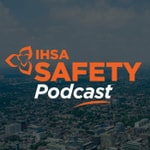IHSA Safety Podcast – Details, episodes & analysis
Podcast details
Technical and general information from the podcast's RSS feed.

IHSA Safety Podcast
IHSA Safety Podcast
Frequency: 1 episode/14d. Total Eps: 111

The IHSA Safety Podcast is a free podcast from the Infrastructure Health and Safety Association that seeks to improve the lives of workers in Ontario; one thought-provoking discussion at a time.
<p>We engage with professionals and industry influencers to help them implement and improve health and safety solutions for workers and the workplace. Each episode explores best practices, resources, and training to control and eliminate safety hazards in work environments involving high-risk activities in the industries that IHSA serves: construction, transportation, and electric utilities
Recent rankings
Latest chart positions across Apple Podcasts and Spotify rankings.
Apple Podcasts
🇨🇦 Canada - howTo
06/07/2025#94🇨🇦 Canada - howTo
05/07/2025#63🇨🇦 Canada - howTo
04/07/2025#45🇨🇦 Canada - howTo
17/06/2025#75🇨🇦 Canada - howTo
16/06/2025#51🇨🇦 Canada - howTo
11/06/2025#59🇨🇦 Canada - howTo
10/06/2025#46🇨🇦 Canada - howTo
09/06/2025#91🇨🇦 Canada - howTo
08/06/2025#70🇨🇦 Canada - howTo
07/06/2025#44
Spotify
No recent rankings available
Shared links between episodes and podcasts
Links found in episode descriptions and other podcasts that share them.
See all- https://ccdi.ca/
40 shares
- https://www.ihsasafetypodcast.ca
34 shares
- https://food-guide.canada.ca/en/
13 shares
RSS feed quality and score
Technical evaluation of the podcast's RSS feed quality and structure.
See allScore global : 63%
Publication history
Monthly episode publishing history over the past years.
Impact of Senior Management on the Performance of an Occupational Health and Safety Management System (OHSMS)
Episode 90
dimanche 25 août 2024 • Duration 34:08
On this episode of the IHSA Safety Podcast, IHSA’s Maren Gamble discusses the impact of senior management on the performance of an occupational health and safety management system (OHSMS). A senior manager’s level of commitment towards their OHSMS is a critical factor to its success. For example, a senior manager's involvement, such as attending meetings, having knowledge of the system, and having a good understanding of the internal audit process, can significantly impact the success of the system.
Maren emphasizes that senior management should lead by example, as their actions send a message that health and safety is important and worth their time. When they visit a construction site, for instance, a senior manager should not only adhere to mandatory personal protective equipment (PPE) and other safety measures, but they should also insist that these rules apply to everyone, demonstrating that there are no exceptions to these rules. If a senior manager or president of a construction project were to be seen wearing dress shoes on the jobsite instead of the proper PPE, it sends the wrong message that PPE is optional and the rules are not applicable to everyone.
To ensure that they keep the promise and commitment they made to their workers to support them in making it home safely, senior management should regularly review the proactive controls being developed within their OHSMS to ensure they are comfortable with them and confident in their ability to meet their health and safety obligations.
Free Resources
The Working Mind for the Trades – Manager (Virtual Training)
See Privacy Policy at https://art19.com/privacy and California Privacy Notice at https://art19.com/privacy#do-not-sell-my-info.
Corrective Action and Preventative Action
Episode 89
lundi 12 août 2024 • Duration 21:17
On this episode of the IHSA Safety Podcast, IHSA’s Maren Gamble discusses the distinction between two concepts that are often confused in health and safety: corrective action and preventative action.
Corrective actions are taken in response to existing hazards or incidents in the workplace. Preventative actions, on the other hand, take a more proactive approach with the aim to minimize or eliminate hazards and prevent incidents from reoccurring. The difference between the two is that one focuses on dealing with an incident as it happens, while the other focuses on how to stop the incident from happening again.
Maren shares some real-life examples of what a corrective action may look like versus a preventative action. If a fire were to break out, for example, a corrective action would be to put out the fire. A preventative action would be to eliminate the root cause of the fire to prevent future outbreaks.
Maren also emphasizes the importance of considering both corrective and preventative action plans when building an occupational health and safety management system (OHSMS). If we focus solely on corrective action, there’ll be an increased number of incidents to address in future because of the lack of a preventative action plan in place. If we focus solely on preventative action and an incident occurs that calls for corrective action, we will find ourselves unprepared. Both action plans are necessary for maximizing efficiency and maintaining worker health and safety.
Free resources
Hazards, Risks, Assessment, and Control (IHSA Podcast – Episode 75)
The Plan, Do, Check, Act (PDCA) Model: A Deeper Dive (IHSA Podcast – Episode 67)
IHSA Magazine: Plan, Do, Check, Act
Occupational Health and Safety: The Physical Work Environment
Hierarchy of Controls (YouTube)
See Privacy Policy at https://art19.com/privacy and California Privacy Notice at https://art19.com/privacy#do-not-sell-my-info.
Women in Construction Health and Safety
Episode 80
lundi 8 avril 2024 • Duration 39:53
On this episode of the IHSA Safety Podcast, three members of IHSA's management team discuss women in construction health and safety. Maren Gamble, manager of Strategic Programs, Deb Moskal, manager of Regional Operations North and East, and Jennifer McKenzie, director of Stakeholder and Client Engagement, address the long-standing gender disparity in the construction industry.
Maren shares her experiences as a female in a largely male-dominated workplace, specifically in construction health and safety spaces. Jennifer acknowledges the progress made in breaking down barriers in the construction industry and discusses the roles leadership and management play in encouraging gender equality in the workplace. Deb emphasizes the immense value female workers bring to the industry and the need for more inclusivity.
Maren, Deb, and Jennifer further highlight the importance of addressing gender diversity in the workplace. Maren applies the hierarchy of controls formula to tackle the issue of gender bias and stereotypes about women in construction, one of which includes fostering a gender-inclusive culture. While the skilled trades and construction industry continues to evolve and there has been remarkable progress in attracting more women to the industry, workers, employers, and the construction industry as a whole can do more collectively to create a more equitable future.
Free Resources
Challenging stigma and preventing mental harm
Safety talk: Toxic masculinity
See Privacy Policy at https://art19.com/privacy and California Privacy Notice at https://art19.com/privacy#do-not-sell-my-info.
Utility Work Protection Code
Episode 79
lundi 25 mars 2024 • Duration 22:58
This episode of the IHSA Safety Podcast discusses the Utility Work Protection Code (UWPC), a set of rules and regulations that play a crucial role in worker safety across Ontario, and features Sandy Morrison, Utility Work Protection Code coordinator at IHSA. The UWPC, owned by Hydro One and updated every five years, ensures that rules, tags, forms, and communication are consistent. The UWPC helps create an environment where hazards are reduced or eliminated by providing rules for workers working on or above 750 volts. It is based on the understanding that the safest way to work is to isolate an area and work around it using different permits and tags to create a safe work environment.
Sandy addresses the importance of training in the UWPC for crews working around high voltage. Training is only valid for 27 months and must be retaken after two years. This ongoing training process allows workers to learn new skills and address new questions or scenarios. IHSA offers four training courses in the UWPC: Overview, Core, Recertification, and Train the Trainer.
Sandy also discusses the UWPC’s significant changes in 2024, which include new code changes that match the Electrical Utility Safety Rules (EUSR), implementation of a signature rule, an annual management review, creation of a new PC3 tag, and more.
Free Resources
Utility Work Protection Code Overview
Electrical Utilities Safety Rules (EUSR)
Electrical Safety Awareness (eLearning)
See Privacy Policy at https://art19.com/privacy and California Privacy Notice at https://art19.com/privacy#do-not-sell-my-info.
Training vs. Competency
Episode 78
lundi 11 mars 2024 • Duration 41:25
Employers often provide training to ensure workers are equipped for a job, with formal training requirements and courses being especially important. However, there are differences between training and competency, and it is essential to explore the distinction between the two terms when building an occupational health and safety management system (OHSMS). This episode of the IHSA Safety Podcast discusses training and competency and features Maren Gamble, Manager of Strategic Programs at IHSA.
Maren highlights that training involves learning new skills to properly perform a specific job or activity, but may not cover all the necessary knowledge for the specific task. Competency, on the other hand, encompasses knowledge, experience, and training, ensuring a person is ready to safely perform tasks. It involves having accurate, current information, the right training, and applicable experience to organize and perform work, know the laws associated with it, and understand potential dangers or hazards.
Maren further discusses the layers involved in developing competency, including both internal and external factors such as licensing or certifications. Maren also stresses the need to verify competency—in addition to verifying training—through evaluation, interview, or observation of work to help identify any gaps in understanding.
Free Resources
Basics of Health and Safety for Small Businesses (eLearning)
NCSO Health and Safety, Policies, Practices, and Procedures Webinar
See Privacy Policy at https://art19.com/privacy and California Privacy Notice at https://art19.com/privacy#do-not-sell-my-info.
Electrical Utility Safety Rules (EUSR)
Episode 77
lundi 26 février 2024 • Duration 15:20
This episode of the IHSA Safety Podcast discusses the Electrical Utility Safety Rules (EUSR), which have been the foundation of health and safety education in the electrical utilities industry since 1914, and features Jeff Ellery, a member of IHSA's Power Line Apprenticeship and training team. The EUSR, initially created by the Electrical Employers Association of Ontario, laid down a set of rules for safe work for electrical workers who work on or near electrical distribution or transmission systems in Ontario. These workers include power line technicians, utility arborists, and high-voltage electrical workers.
Jeff explains that the EUSR was established in 1914 because of the critical need for a documented set of safety rules due to the high number of incidents and workplace fatalities in the electrical utility sector. The EUSR can be credited with contributing to the foundational elementsfound in the current Ontario's Occupational Health and Safety Act, such as workers' rights, competent supervision, requirements for personal protective equipment (PPE), and worker resuscitation and first aid. The EUSR is regarded as a best practice within the electrical utilitiessector.
The EUSR has undergone significant revisions since its formation, and Jeff discusses the parties involved in its evolution, as well as the recent changes that went into effect on January 1, 2024.
The 2024 edition of the EUSR is now available in print and online at IHSA.ca.
Free Resources
Electrical Utilities Safety Rules (EUSR)
Electrical Safety Awareness (eLearning)
See Privacy Policy at https://art19.com/privacy and California Privacy Notice at https://art19.com/privacy#do-not-sell-my-info.
Working Outside in the Canadian Winter
Episode 76
lundi 12 février 2024 • Duration 12:34
During the winter months in Canada, the weather can get extremely cold, and workers in industries such as construction, transportation, and electrical utilities face the risk of experiencing cold stress. On this episode of the IHSA Safety Podcast, Jasmine Kalsi, IHSA’s Occupational Hygienist, discusses cold stress, which occurs when the human body's core temperature drops below 37 degrees Celsius. Cold stress can result in cold-related illnesses, tissue damage, and even death.
Jasmine explains that extended exposures to cold can occur in locations such as roofs, unheated cabs, bridges, projects near large bodies of water, high buildings open to the wind, and working in refrigerated rooms, vessels, and containers. Cold stress can result in two major illnesses: hypothermia and frostbite. Hypothermia occurs when the body cannot maintain its core temperature due to constricting blood vessels, while frostbite is caused by exposure to severe cold or contact with extremely cold surfaces.
Jasmine further discusses the responsibilities of employers to take reasonable precautions to protect workers from cold stress. Controls that can be implemented include training, safety talks, providing appropriate protective clothing, providing hot beverages and heated shelters or breakrooms, and creating a cold stress prevention plan.
Free Resources
WorkSafe Saskatchewan - Working in Cold Conditions
CCOHS Cold Environments – ACGIH Wind Chill Temperature Index
See Privacy Policy at https://art19.com/privacy and California Privacy Notice at https://art19.com/privacy#do-not-sell-my-info.
Hazards, Risks, Assessment, and Control
Episode 75
lundi 29 janvier 2024 • Duration 36:44
To build an effective occupational health and safety management system, it is crucial to adopt a proactive approach to risk prevention rather than a reactive one. This episode of the IHSA Safety Podcast discusses the basics of hazards, risks, assessment, and controls within an occupational health and safety management system and features Maren Gamble, Manager of Strategic Programs at IHSA.
Maren discusses the proactive approach in depth, which focuses on predicting and foreseeing potential risks before the job starts. Maren compares this to baby-proofing or pet-proofing a house by identifying potential hazards to an infant or a new pet and putting control measures in place.
Maren further emphasizes the importance of understanding the distinction between hazard, risk, assessment, and control. The hazard in a workplace is what causes harm, while the risk is the type of harm it can cause. It’s important to consider the hazard that existed to cause that risk, as this helps identify other risks associated with the same hazard.
Maren also discusses the best way to address risks, which is to implement controls. Some types of controls are better than others, leading to the control hierarchy as follows: Elimination, substitution, engineering controls, administrative controls, and personal protective equipment (PPE).
Free Resources
Hazard Identification and Control Awareness in Construction (eLearning)
Intro to Hazard and Risk Management (eLearning)
Hierarchy of Controls (YouTube)
Hazard Assessment, Analysis, and Control (COR® Podcast – Episode 6)
Trauma Management in the Workplace (IHSA Podcast – Episode 70)
See Privacy Policy at https://art19.com/privacy and California Privacy Notice at https://art19.com/privacy#do-not-sell-my-info.
A Look Back at the Life of an OHS Professional
Episode 74
mardi 16 janvier 2024 • Duration 29:25
On this episode of the IHSA Safety Podcast, we celebrate the career of an occupational health and safety professional, Tom Nicolls. Tom started his career in the Electrical Utility industry 38 years ago with Hydro One, and has been a significant contributor to occupational health and safety in Ontario through various channels and roles.
Tom shares his experiences over the length of his extensive career, including his inspiration to pursue a career in health and safety after witnessing severe accidents as a lineman at Ontario Hydro and recognizing the critical need for safety protocols. He went on to become an Occupational Health and Safety Specialist with the Power Workers Union, which represents 90% of electrical workers in distribution, transmission, and generation of power across Ontario.
One memorable moment from Tom’s career was his involvement in standardizing the Utility Work Protection Code across the province after an ice storm in Toronto. The code ensures the safety of workers in distribution and transmission systems in Ontario, and its standardization has had a long-lasting effect across the province.
Tom has dedicated a lot of his time to volunteer activities, committees, and boards, including serving as chair of Section 21 Utility Provincial Labour Management Committee, as well as co-chair on the Board of IHSA.
Free Resources
Learn about the dangers of working around electrical hazards (ihsa.ca)
Occupational Health and Safety: The Physical Work Environment
See Privacy Policy at https://art19.com/privacy and California Privacy Notice at https://art19.com/privacy#do-not-sell-my-info.
Worker Misclassification (Part 3 of the ESDC series)
Episode 73
mardi 2 janvier 2024 • Duration 14:18
Worker misclassification can have ramifications for all parties involved. When a worker is misclassified, it prevents them from receiving the full benefits and protections they are entitled to under the Canada Labour Code. This episode of the IHSA Safety Podcast (the final in a three-part series) discusses worker misclassification in transportation and features Liz Tavares, Occupational Health and Safety Officer, Employment and Social Development Canada (ESDC)—Labour Program/Government of Canada, and Michelle Roberts, Vice President, Stakeholder and Public Relations at IHSA.
Worker misclassification, as explained by Liz, is the improper designation of an employee and occurs when an employer intentionally treats a worker who meets the criteria to be an employee as someone other than an employee. As a result, the worker or driver is not afforded the same rights and protections as other employees in the industry.
Liz and Michelle further highlight the risks associated with misclassification for both workers and employers, as well as the steps by which misclassification can be addressed. The first is through guidance and counselling, followed by other compliance measures such as Assurance of Voluntary Compliance (AVC), Compliance Order, and more.
Free Resources
Reporting requirements for federally regulated firms
Legislative Requirements and Best Practices
Transportation: Links & Resources
Misclassification in the Trucking Industry - Government of Canada
ESDC Video: Misclassification Know your Rights: https://youtu.be/HdQdNTcvvVA?si=rDDM4ZCWlt1zYHmh
See Privacy Policy at https://art19.com/privacy and California Privacy Notice at https://art19.com/privacy#do-not-sell-my-info.









